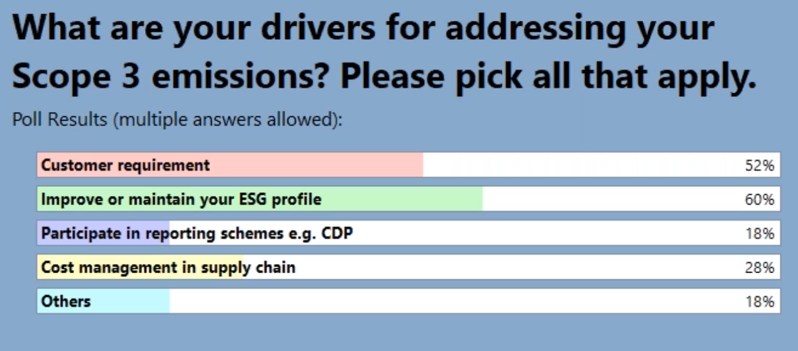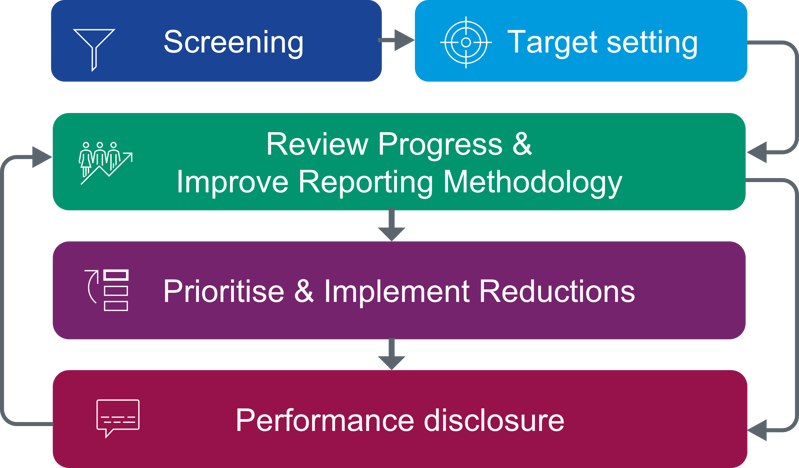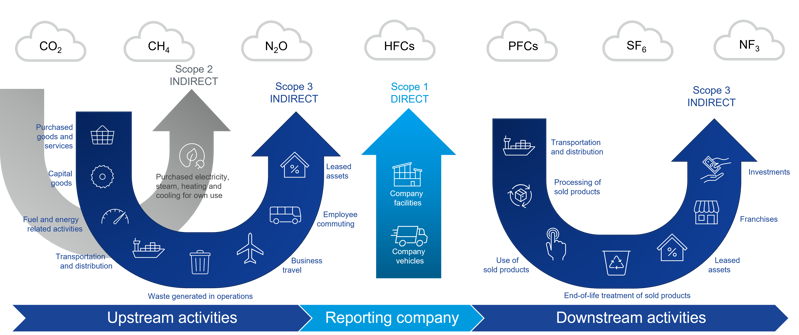3 key insights from our work on Scope 3 (value chain) carbon emissions, so far…
Ricardo’s team of carbon management experts have been working with a number of clients to help them reduce carbon emissions along their upstream and downstream value chain, known as Scope 3 emissions. In this blog, Scope 3 expert, Fern Spencer, shares some of the key insights gained from this work.
What are Scope 3 emissions?
Scope 3 (or ‘value chain’) emissions are the indirect greenhouse gas (GHG) emissions in your organisation’s value chain outside of your own operations. They include areas like business travel, water and waste processing, and purchased goods and services. Scope 3 emissions are indirect emissions and are always the Scope 1 and 2 emissions of others. As such, targeting Scope 3 emissions is not just about reducing your organisation’s own emissions, it’s about supporting the global drive towards a low carbon future.
Your Scope 3 emissions are likely to account for over 90% of your organisation’s carbon footprint.
Scope 3 is an area of carbon reporting and management that has undergone a high level of growth and development in the past few years. Organisations have gone from barely recognising most types of Scope 3 emissions, to working hard to measure, disclose and set targets to reduce them in a short space of time. We have condensed our learnings into 3 key insights on Scope 3, so far…
1. There are many drivers increasing the focus on Scope 3 emissions
We have seen multiple different drivers for organisations wanting to estimate, understand and reduce their scope 3 emissions. The main ones are:
- Investor pressure: Environmental, Social and Governance (ESG) KPIs are rapidly becoming a key factor in investment strategy, with full GHG disclosure including Scope 3 an important factor when selecting companies to invest in.
- TCFD: As well as requiring clarity on physical climate change risks, reporting in line with the Taskforce on Climate-Related Financial Disclosures framework also strongly recommends businesses to publish full GHG disclosure including Scope 3, to highlight exposure to high-emitting sectors within their value chains.
- Suppliers and customers: The majority of businesses are receiving requests to publish their GHG emissions by their suppliers and customers, as they in turn seek to improve the visibility of their own Scope 3 emissions.
- Consumers: Organisations need to demonstrate good environmental performance to customers as the conscious consumer market grows.
- Net zero strategy and Scope 3 target setting: To set robust decarbonisation and net zero emissions targets in line with the Science Based Targets initiative (SBTi), a full Scope 3 inventory must be compiled, and targets set against it.
- CDP scores: Many organisations are looking to boost their CDP climate change scores which increasingly make a company more attractive to potential investors.
- Cost and carbon exposure: A thorough Scope 3 review can help identify areas of excessive cost and emissions throughout the supply chain which can be prioritised for action.
- Preparedness: Forward-thinking organisations are looking to increase their adaptability to the ever-increasing legislation on Scope 3 in environmental reporting. For example, it is expected that Streamlined Energy and Carbon Reporting will in future require Scope 3 disclosures.
The UK Transition Plan Taskforce (TPT) is a prime example of the increasing legislative pressure on companies to justify their carbon emissions and net zero plans. At COP26, the UK Chancellor announced that the UK Government will require large companies to publish their transition plans from 2023 under the TCFD reporting framework. The TPT was mandated following this to tackle greenwashing in net zero reporting, with the first consultation in May this year. An emphasis on the transparency and robustness of Scope 3 accounting and reporting is likely to be reflected in it.
In a recent Scope 3 webinar we hosted in partnership with the Food and Drink Federation (FDF), more than half the participants of a survey found customer requirements and improving/maintaining ESG profiles were important drivers for addressing their scope 3 emissions. This simply emphasises these drivers.

Whatever position you view it from, GHG emissions must be reduced to avoid the catastrophic impacts of climate change and organisations must address Scope 3 emissions if they are to properly manage their impact. The pressure is ramping up, and many organisations are rising to the challenge.
How is your organisation responding?
2. Analysis paralysis is a real challenge
In recent webinars with clients, we asked participants what their main challenge was in estimating Scope 3 emissions. Nearly half stated this was data availability and collection. Given this is the first port of call when estimating emissions, the challenge certainly isn’t small as Scope 3 emissions essentially seek to evaluate the emissions associated with all of your organisation’s operations.
While reporting all Scope 3 emissions isn’t mandatory under current UK Government legislation, a recent consultation suggests it may be in future. Because of this, and the drivers listed above, we recommend that our clients carry out a Scope 3 screening inventory to evaluate the full range of their Scope 3 emissions. This not only lets them know their starting position but provides valuable data for disclosure to stakeholders and aligns them with multiple reporting standards, ready for new legislation and pressures that come their way. Our blog post on ‘Whose carbon is it anyway’ summarises this discussion.
As an example, if you are a manufacturing company who uses steel to produce boilers; within Scope 3 you should account for all emissions associated with getting the steel and other components to your factory (mining, processing, transport) and then also the emissions associated with transporting your products, their in-life use by customers, and their end-of-life disposal.
Scope 3 also has important ramifications for sectors such as finance, who should account for emissions from third party companies they own, and commercial landlords who must account for emissions from the buildings they rent out.
The Scope 3 boundary is more complicated than a one size fits all approach and estimating these emissions as accurately as possible can be daunting. All organisations experience this to some level.
Therefore, it is important not to get caught up in ‘paralysis by analysis’.

Paralysis by analysis can occur where excessive time is spent finding the best estimates for Scope 3 in lieu of action, which delays any actual emission reductions. This is the very thing we need to avoid, as climate targets move closer and the pressure to decarbonise increases.
To avoid this phenomenon, you need to find a balance between accuracy of measurement and action to reduce emissions.
Estimating Scope 3 emissions first, through a screening, allows organisations to understand their hotspots, and therefore determine where action is likely to have the most impact and where more detailed accounting is necessary.
Working with clients to tackle Scope 3 emissions

3. Beyond Estimation, towards reduction
Once you've produced your initial Scope 3 screening inventory, organisations should recap on the methodology they have used and assess if it is fit for tracking emissions performance over time. This means ensuring the methodology can capture any reductions in emissions in future reporting.
As we discussed in our Scope 3 video mini-series, improving your understanding around your organisation's Scope 3 emissions is a journey. The spend based methodology for estimating Scope 3 emissions from purchased goods and services, for example, is good at identifying hotspots in your Scope 3 footprint in the least resource intensive manner.
However, the main way to demonstrate a reduction in emissions over time through this method is to reduce spend, which is not compatible with most business models. It is also not a fair representation of how actual emissions change over time.
Therefore, many of our clients are now moving away from initial spend-based screening, where possible, towards an activity-based approach such as capturing quantities of manufacturing input materials, and emissions and mileage data from transport suppliers. They are also making progress to improve their data capture and estimation methodology, alongside introducing initiatives to reduce scope 3 emissions.
An organisation that supports capture of emissions data from suppliers is Manufacture 2030. M2030 offers a cloud-based platform that makes it cost-effective and straightforward for you to work with thousands of suppliers. Unlike other platforms, this solution gives you more than just a view of your supply chain footprint. The platform provides individual carbon baselines (footprints) along with forward visibility using glidepath reports, meaning that you can see whether individual supplier sites are tracking to your target, where the gaps are, and actively work with them to close those gaps using individual decarbonisation plans for each supplier, developed with support from M2030. The important aspect is that M2030 actively works with the suppliers to reduce their carbon emissions and your Scope 3 emissions, therefore giving you greater certainty that you will meet your public environmental commitments.
As net zero and emission reduction targets loom near, the pressure to demonstrate Scope 3 emission reductions will increase.
Improving data capture and estimation methodology means that you can demonstrate your emissions reductions to all interested stakeholders. This step-by-step process makes the ‘Scope 3 problem’ a lot easier to tackle.
Simply setting targets is not enough. It is of the utmost importance that your organisation knows how it will achieve its targets and can demonstrate this credibly and transparently. There are hundreds of ways that organisations can reduce their value chain emissions. Drawing on our expertise from our multidisciplinary teams, we work with organisations to uncover the right measures for them to take and when, and then we can help them with the implementation of these measures.

Solutions to the Scope 3 problem look different for each emission source and organisation. This is why there is no one-size-fits-all approach for measuring and reducing scope 3 emissions.
Get in touch, using the button below to find out more about our bespoke approach to your Scope 3 issues and how solutions can be tailored to your organisation’s needs.










